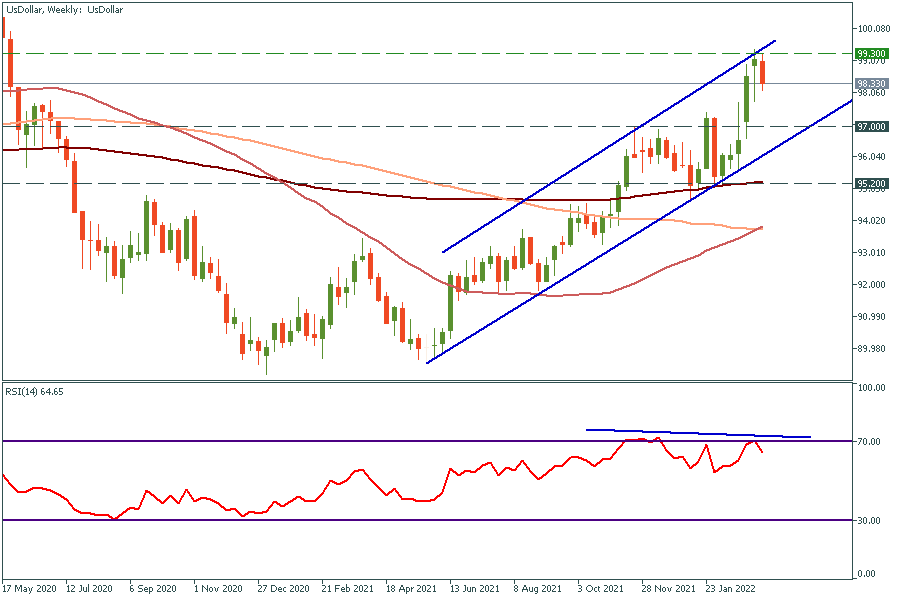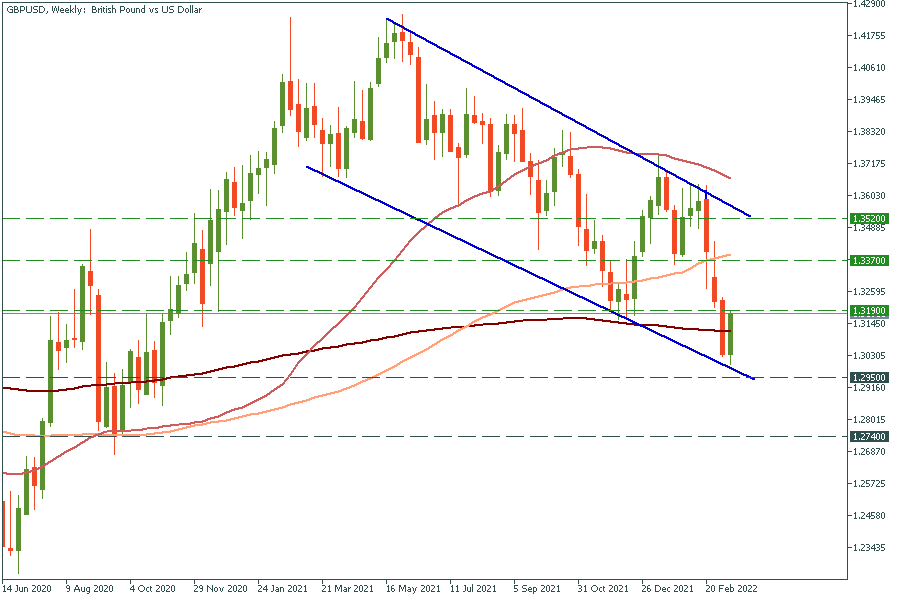อำนาจของ USD ถึงคราวสิ้นสุดลง
เมื่อวันที่ 16 มีนาคม ธนาคารกลางสหรัฐฯ ได้จัดงานแถลงข่าว โดยได้ประกาศข้อเท็จจริงที่น่าผิดหวังหลายประการของเศรษฐกิจสหรัฐฯ FOMC ปรับเพิ่มประมาณการของอัตราเงินเฟ้อสหรัฐฯ ในปี 2022 เป็น 4.3% จาก 2.6% ถึงแม้ว่าจะมีการปรับขึ้นอัตราดอกเบี้ยหลักก็ตาม นอกจากนี้ FED ได้ปรับลดการคาดการณ์สำหรับ GDP ของสหรัฐอเมริกาของปี 2022 ลงอย่างมาก โดยปรับเป็น 2.8% จาก 4%
นักการเมืองของสหรัฐฯ และทำเนียบขาวโทษว่าเป็นเพราะความขัดแย้งของรัสเซีย-ยูเครน รวมถึงปัญหาห่วงโซ่อุปทานสำหรับอัตราเงินเฟ้อที่เพิ่มขึ้นด้วย อย่างไรก็ตาม ดูเหมือนว่าจะเป็นเพียงข้อแก้ตัวสำหรับนโยบายการเงินที่ล้มเหลว การเติบโตของราคาที่เพิ่มขึ้นอย่างรุนแรง และหนี้ของภาครัฐจำนวนมาก
เกิดอะไรขึ้น?
ดอลลาร์สหรัฐเป็นสกุลเงินสำรองตั้งแต่ปี 1944 นอกจากนี้ แม้กระทั่งจนถึงทุกวันนี้ การทำธุรกรรมสำหรับน้ำมันส่วนใหญ่ยังคำนวณในสกุลเงินดอลลาร์ ซึ่งสนับสนุนสกุลเงินดอลลาร์สหรัฐ อย่างไรก็ตาม ทุกวันนี้ ผู้นำของประเทศที่ใหญ่ที่สุดและประเทศที่พัฒนาแล้วที่สุดในโลก เช่น จีน รัสเซีย ซาอุดีอาระเบีย และอินเดีย ได้ใช้ระบบการชำระเงินแบบใหม่ ซึ่งจะไม่นับรวมดอลลาร์สหรัฐ
ซาอุดีอาระเบียพิจารณาใช้เงินหยวนแทนดอลลาร์สหรัฐ เพื่อจ่ายน้ำมันส่วนหนึ่งที่ราชอาณาจักรผลิตให้กับจีน จีนซื้อน้ำมันมากกว่า 25% ที่ส่งออกจากซาอุดิอาระเบีย และราชอาณาจักรก็เป็นซัปพลายเออร์น้ำมันรายใหญ่ที่สุดของจีน เจ้าหน้าที่ของซาอุดิอาระเบียและตัวแทนของธุรกิจขนาดใหญ่ไม่พอใจในนโยบายต่างประเทศของการบริหารงานของประธานาธิบดีสหรัฐฯ มากขึ้นเรื่อยๆ
อินเดียและรัสเซียยังพิจารณาที่จะไม่รวมเงินดอลลาร์สหรัฐเพื่อใช้ในการชำระเงิน และย้ายไปใช้การชำระหนี้การค้าในสกุลเงินรูเบิลและรูปีแทน ทั้งสองฝ่ายต้องการใช้หยวนจีนเป็นสกุลเงินหลัก กลไกใหม่นี้จะช่วยให้ผู้ส่งออกของอินเดียสามารถชำระค่าสินค้าในสกุลเงินของประเทศแทนดอลลาร์หรือยูโรได้
นวัตกรรมเหล่านี้ในภูมิภาคเอเชียสามารถลดความต้องการเงินดอลลาร์สหรัฐและทำให้ค่าเงินนี้อ่อนค่าลงได้อย่างมาก
การคาดการณ์สำหรับ USD
FED ติดอยู่ระหว่างอัตราเงินเฟ้อที่สูงมากกับหนี้รัฐบาลที่เพิ่มสูงขึ้นของสหรัฐฯ มันอาจเป็นปัญหากับ USD ในอนาคตอันใกล้นี้ โลกอาจสูญเสียความไว้วางใจในทำเนียบขาวและหันไปใช้สกุลเงินอื่น เช่น หยวนจีน
กราฟรายสัปดาห์ของ USD
แนวต้าน: 99.3
แนวรับ: 97

ดัชนีดอลลาร์สหรัฐ (DXY) ก่อตัวแบบ bearish divergence ในกรอบเวลารายสัปดาห์ ราคาอาจร่วงลงไปที่ 97 ภายในสองถึงสามสัปดาห์ นอกจากนี้ ในกรณีที่มีการพุ่งทะลุขอบล่างไปได้ เราอาจเห็นการลดลงไปกว่าเดิมอีกเป็น 95.2
กราฟรายสัปดาห์ของ GBPUSD
แนวรับ: 1.3190, 1.3370, 1.3520
แนวรับ: 1.2950, 1.2740

ธนาคารแห่งประเทศอังกฤษเป็นประเทศที่เพิ่มอัตราดอกเบี้ยที่สำคัญเป็นประเทศแรก ในวันที่ 17 มีนาคม ผู้กำหนดนโยบายอาจปรับขึ้นอัตราดอกเบี้ยเป็นครั้งที่สามเป็น 0.75 ในระยะยาว ขั้นตอนดังกล่าวอาจส่งผลกระทบอย่างมีนัยสำคัญต่อ GBP และดันให้พุ่งสูงขึ้นเมื่อเทียบกับสกุลเงินอื่น
แผนภูมิได้ก่อตัวเป็นรูปแบบธงขาขึ้น (bullish flag) เทรดเดอร์อาจพิจารณาซื้อ GBPUSD ที่ระดับแนวรับที่ 1.2950 หรือหลังจากที่มีการทะลุขอบบนของธงนี้ไป
